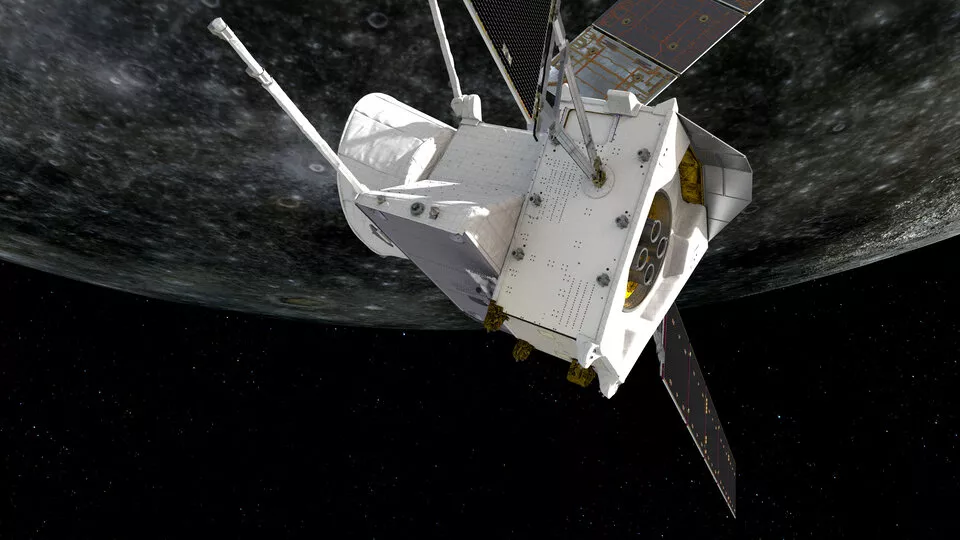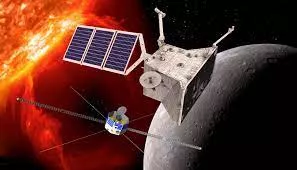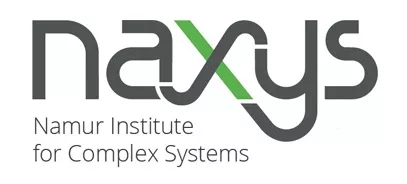
Mercury still holds many mysteries. To date, only two space missions in the 1970s and 2000s have been able to study the planet. To better understand how it works and how it was formed, a probe was sent there in 2018: the Bepicolombo mission.
Read the full ESA post about the flyby on 19 June 2023 at 21:34 (CEST)
A 12-year project coordinated by the European (ESA) and Japanese (JAXA) space agencies, in which researchers from the SPACE pole of the naXys Institute took part through Professor Anne Lemaître's ROMEO (Rotation Of Mercury and Equations of an Orbiter) project, funded by the ESA, the FNRS and the UNamur.
The team of researchers who worked on the project: Nicolas Rambaux, Julien Dufey, Juan Navarro, Sandrine D’Hoedt, Benoit Noyelles, Sébastien Wailliez, Julien Frouard, Christoph Lotka, Damya Souami, and Marco Sansottera.

The space mission has a number of objectives: to study the formation and evolution of the planet in order to gain a better understanding of the formation of the solar system, and to analyse its geology and craters. It will also examine the planet's orbit, magnetosphere, atmosphere, water and ice, as well as its cosmic environment. The ROMEO project focused on the structure of Mercury's core and its composition.
A partly raw core
Mercury is the only planet in our solar system that rotates with a 3:2 conjunction. In other words, it rotates three times on itself while making two revolutions around the Sun.

Natural satellites such as the Moon operate according to synchronous rotation: one rotation on itself for the time of one revolution around the Sun. The type of rotation of a planet is important because it gives an indication of its nature (density, composition, etc.). In the same way that a raw egg will spin more slowly than a hard-boiled egg, the composition of a planet's core influences its rotation.
The mechanisms that researchers are proposing to explain Mercury's rotation must also explain why Mercury has a very high density and an abnormally high proportion of heavy elements.
Super calculations
Super calculations
The researchers are basing their calculations on existing theories: firstly, the tidal theory, which explains that when a planet completes its formation, it rotates rapidly and then slows down slowly due to tidal effects (gravitational action of the Sun), and secondly, the theory that explains Mercury's composition by assuming a slow evaporation of light elements.
The novelty of the Namur researchers' approach is to combine these with the most realistic possible description of the material that makes up Mercury. To do this, they carry out numerous complex numerical simulations, which can be performed using UNamur PTCI facility Hercules supercomputer.
This theoretical work is helping to prepare effective tests for when the satellite orbits Mercury and sends back its data.

UniversEH: new opportunities in the space sector
Since December 2022, UNamur has been part of the European Space University for Earth and Humanity (UniversEH) alliance, which focuses on space. This is genuine recognition of the UNamur expertise in the field of space, and a gateway to new international collaboration in both teaching and research, in a field that is generating employment and socio-economic development.
BepiColombo is one of the research projects confirming the expertise of Namur researchers in the field of space.
Another ESA mission is JUICE, in which post-doctoral researcher Alexis Coyette and Professor Anne-Sophie Libert are looking at Ganymede, one of the moons of Jupiter.
Upcoming activities of the naXys Institute's SPACE pole
From 3 to 7 July 2023, the naXys Institute is organising the international conference Complex Planetary Systems II (CPSII), a symposium of the International Astronomical Union that has been awarded the Kavli label for its interdisciplinarity and will welcome 150 international researchers specialising in planetary systems.

All planetary systems, from the Earth-Moon system to extrasolar systems, are complex systems, requiring several levels of expertise and interdisciplinarity to be fully understood. Building on the success of the first edition "Complex Planetary Systems" in 2014, CPSII aims to present the latest discoveries obtained from this perspective and generate new collaborations between different disciplines for the future.

